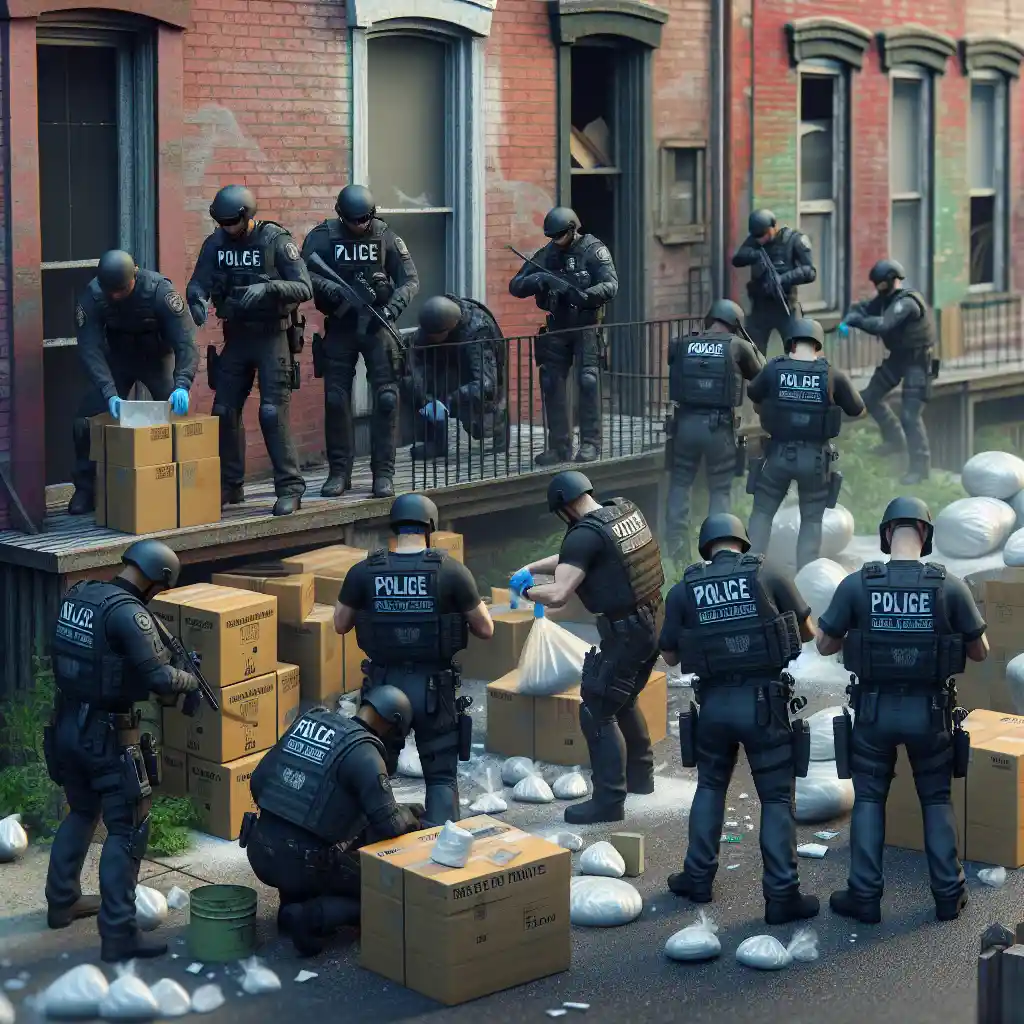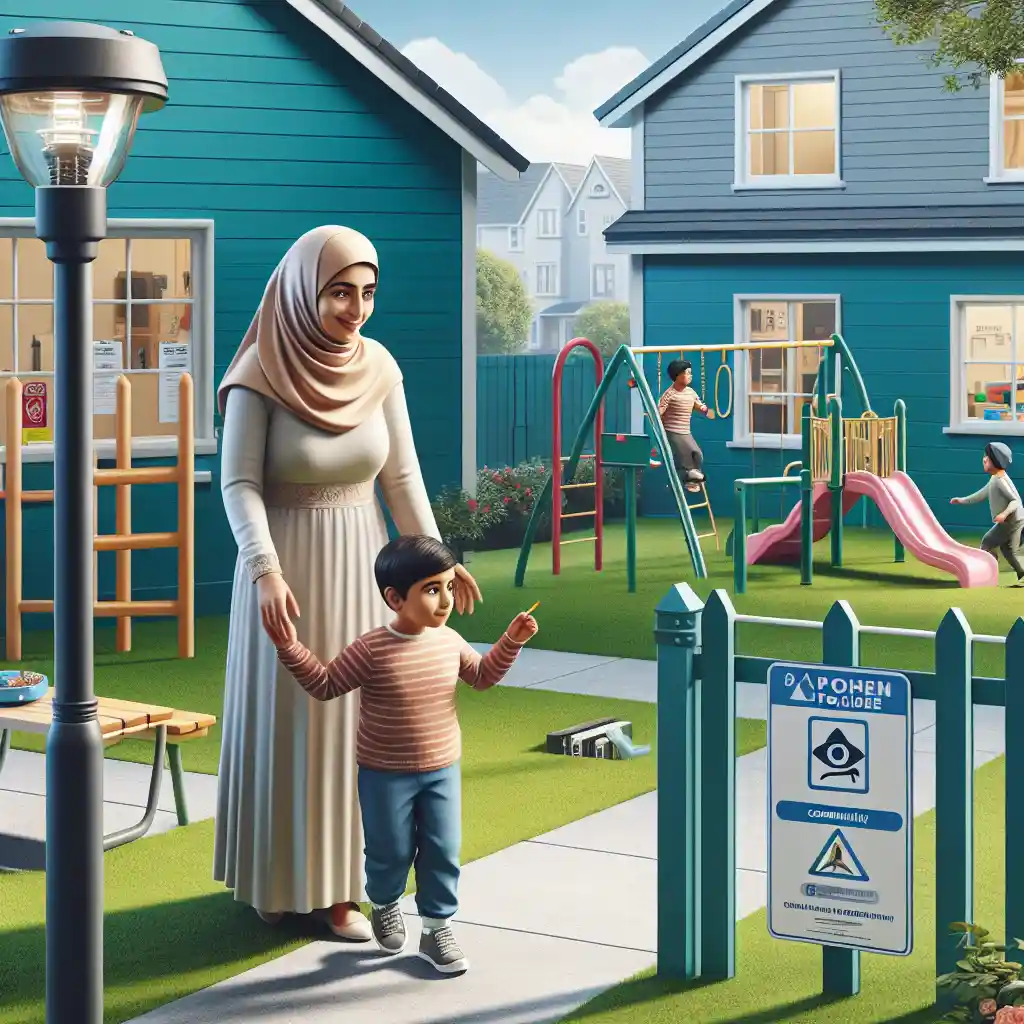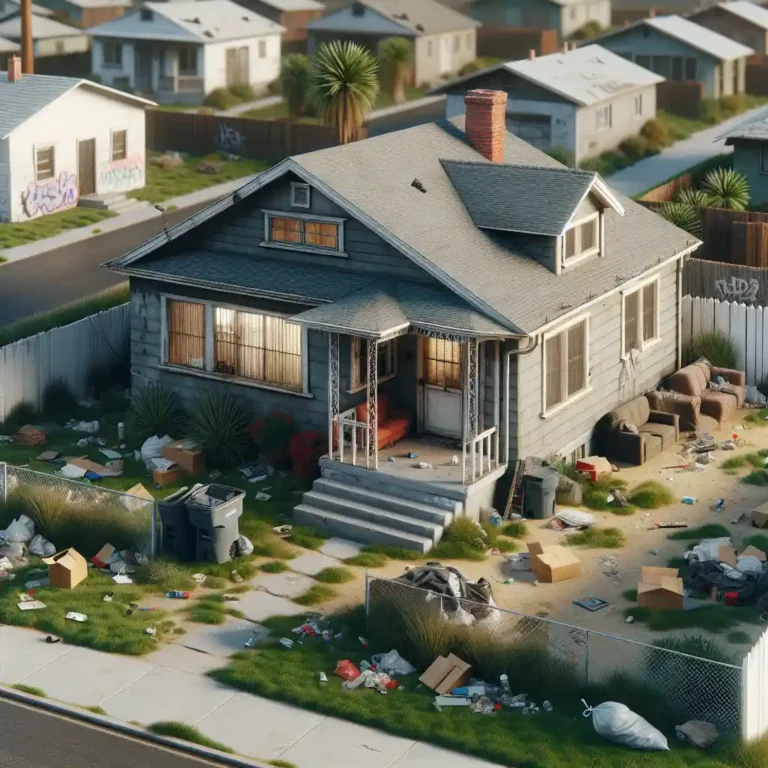Beneath the veneer of dilapidated buildings within urban landscapes lies a malignant reality: the trap house. These inconspicuous structures serve as the seedy underbelly of the drug trade, often slipping through the cracks of public scrutiny. Yet their impact on communities is both profound and pervasive. A trap house, often an unassuming residence, morphs into a hub for illegal drug activity, where transactions are not just about substances, but also trap vulnerable lives in a cycle of dependency and despair. As cities grapple with the proliferation of these entities, understanding their operation and the extent of their reach is critical. This article will delve into the trap house phenomenon, unraveling the dark threads it weaves through the fabric of society and highlighting the urgent need for intervention. From the sorrow-laden tales of those ensnared to the concerted efforts required to dismantle these domains of danger, we explore the full scope of trap houses’ impacts and the paramount importance of safeguarding our communities.
Defining a Trap House
The term “trap house” carries with it a sinister undertone, indicative of places that foster illegal drug activity and a destructive lifestyle. These locations, colloquially known as drug houses or crack houses, are often situated in derelict buildings or secluded corners of low-income neighborhoods. Trap houses are not just simple rendezvous points for transactions but can manifest as toxic nests where drug users seek refuge and drug dealers ply their trade with little regard for the law. Such establishments perpetuate a vicious cycle, entrapping visitors in the dangerous world of illicit drugs and criminal behavior. When considering trap houses, one should tread with utmost caution, recognizing the grave risks associated with these environments.
What is a Trap House?
A trap house is far more than a mere building; it’s a hotspot for illegal transactions and a sanctuary for those enmeshed in the perils of drug use and sales. While some may innocuously refer to any informal dwelling as a “trap house,” the term is closely associated with the sale and consumption of illegal substances. These houses blend into neighborhoods, often commandeering abandoned or neglected properties as bases of operation. Within these walls, activities related to the illicit drug trade ensue—ranging from the storage and distribution of narcotics to the harboring of drug addicts. A trap house can quickly become a neighborhood menace, raising suspicions and concerns among residents due to the potential for increased crime and decline in property values. It is important to be vigilant, and for communities to come together to combat the spread and normalization of these dangerous places.
How do Trap Houses operate?
Operating under the guise of innocuous dwellings, trap houses conduct business discreetly yet robustly, with a continuous flow of individuals seeking illicit drugs. These establishments are not limited to mere transaction points but can evolve into makeshift laboratories for drug synthesis—posing substantial threats to public safety due to the hazardous materials and procedures involved. The trap house environment is characterized by high energy levels, noise, and often suspicious activity, alerting neighbors and law enforcement to potential illicit endeavors within.
While the term may be glamorized by some as a “trap star lifestyle,” the reality harbored within these walls is starkly different, marked by the desperation of drug addicts and the predatory behavior of drug dealers. Transactions often exploit cash-based systems, though an increasingly digital age has seen the rise in the use of gift cards and even credit card payments, raising red flags for credit card companies and financial institutions alert to suspicious patterns of behavior.
These dens of criminal activity are threats to the fabric of communities, drawing on resources meant for the upliftment of neighborhoods, and leaving in their wake a trail of credit card debt, drained savings, and shattered lives. Real estate values are directly influenced as trap houses deter potential residency and investments, further deepening economic despair in affected areas. It’s critical for community members to remain aware, report dangerous activity, and encourage appropriate interventions to dismantle these illegal enterprises before the damage becomes irreparable.
The prevalence of Trap Houses
Trap houses have insidiously woven themselves into the fabric of many communities, particularly within low-income, urban neighborhoods. Their prevalence is a flagrant sign of deeper socioeconomic issues, often acting as a stronghold for gang activity and becoming hotbeds for violence. At their core, trap houses are dominated by drug dealers who offer a smorgasbord of illegal drugs, such as crack cocaine, heroin, marijuana, and other illicit substances that shatter lives and perpetuate cycles of addiction.
Characteristically, these houses exhibit alarmingly high foot traffic with individuals arriving and leaving at all manner of hours. This continuous influx of people contributes to the wear and tear of the neighborhood’s image and safety. The authorities frequently find themselves ensnared in a game of cat and mouse, as dealers cunningly shift locations to cloak their operations. It is a challenge to snuff out these dens of illegal activity effectively, and as a result, trap houses continue to thrive in the shadows.
Dangers Associated with Trap Houses:
- Risk of violence and gang activity
- High levels of drug abuse and associated criminal behavior
- Potential for overdose incidents
- Challenge for law enforcement to maintain surveillance and make arrests
The mere knowledge that trap houses are blighting our streets urges us to maintain a guarded and watchful eye, particularly in neighborhoods marred by economic despair and limited opportunities.
Cities with high Trap House prevalence
Scour maps of crime and poverty in urban landscapes, and you’ll discover communities blighted by the prevalence of trap houses. In cities grappling with economic hardships, it is all too common to find these drug houses nestled between the cracks of society. Abandoned buildings and unfrequented alleyways in these metropolises provide the perfect shroud for the illegal activities that brand the existence of trap houses.
Police reports and neighborhood complaints often pinpoint areas with higher-than-average noise levels and suspicious activity as likely hosts to these dwellings. Efforts to dismantle their operations are met with consternation as trap houses are notorious for being mobile; the locations are frequently altered, sometimes on a weekly basis, making it difficult for law enforcement agencies to keep up and decisively act.
The connection between Trap Houses and the drug epidemic
The cascading effects of trap houses on the drug epidemic cannot be understated. As epicenters for the distribution of commonly abused drugs like meth, cocaine, marijuana, and heroin, trap houses fuel the insatiable demand that underpins the illegal drug trade. Regrettably, the individuals who frequent these houses often teeter on the precipice of overdose or severe side effects, which can be life-threatening.
What’s more, the infusion of highly potent and addictive drugs, such as heroin laced with fentanyl, into the arteries of these communities via trap houses has led to a spike in addiction and the risk of fatal overdoses. These hubs do not operate in isolation; they are intertwined with gang maneuverings and recurrent acts of violence that leave indelible scars on neighborhoods already strained by poverty and neglect.
Epidemic Impact of Trap Houses:
- Appetite for potent, addictive drugs
- Spike in overdoses and addiction rates
- Destabilization of community safety
- Ongoing challenge for public health and law enforcement
To untangle the web spun by the proliferation of trap houses is to address a critical node in the gnarled tree that is the drug epidemic. Communities call for robust intervention, understanding, and action to heal the wounds inflicted by these insidious environments.
Experiences and consequences
Trap houses are more than just buildings; they are corrosive environments that degrade the moral and social fabric of communities. Situated primarily in low-income, urban neighborhoods, they become focal points for gang activity, violence, and incessant drug dealing. It’s not just about transactions, it’s about lives entwined in a relentless cycle of addiction and unlawful conduct.
Growing up in a Trap House
Growing up in a trap house is an unforgiving and perilous experience that traps individuals in a cycle of exposure to illegal drug trade and addiction. This unfortunate reality is often the case in low-income areas where such houses are run by drug dealers dealing with illegal substances, creating an environment ripe for illegal activities. The term ‘trap star’ ironically refers to those deeply entangled in this nefarious world, climbing the dangerous ladder within the drug dealing networks.
In these residences, common drugs and illicit drugs are the commodities that fuel the everyday business. Drug users and drug addicts who inhabit these spaces may find themselves spiraling into deeper levels of substance abuse, further abetting their captivity in this hazardous cycle.
The cash-heavy transactions that bypass credit card payments leave little to no paper trail, making these operations alluring for those seeking extra money at a high moral and legal cost. However, the hidden costs are substantial – credit card companies and legitimate businesses are avoided, while insurance company products like Overpriced Insurance or legitimate insurance sites are often irrelevant in this underworld.
Here is a brief list outlining the essential facts about life growing up in a trap house:
- Nurtured amidst drug dealing and gang violence
- Daily proximity to criminal activity
- Heightened risk of addiction and substance abuse
- Limited access to support services and transitional facilities
- Insidious impact on energy levels and mental health
Such environments can be deafening in both noise levels and their ability to drown out hopes of escape, creating a cautionary tale for anyone who might romantically consider the life of a ‘trap star.’ It’s a stark reminder to regard real estate in these communities with a critical eye, as a cell phone or the offer of quick cash for gift cards can all be part of the suspicious activity that characterizes the trap house reality.
Escaping the cycle of Trap Houses
Escaping the cycle of Trap Houses requires recognizing the dangers they pose and the toll they take on individuals and communities. These houses, often nestled in low-income areas, become epicenters for illegal drug trade and consumption. They aren’t just physical structures but symbolic representations of the trap created by drug addiction and the illicit lifestyle that accompanies it.
To evade this trap, one must understand the risks:
- Potential violence and physical harm, both from criminal elements and law enforcement raids.
- The cycle of addiction, where drug users become ensnared in continuous criminal behavior to sustain their habits.
- The precarious nature of these houses, which frequently relocate to avoid police detection, adding to the instability of those involved.
It’s a cautionary tale: steer clear of these environments that capitalize on the vulnerabilities of drug addicts and low-income residents. Instead of spending extra money on drugs or getting caught in illegal activities, look for legitimate ways to improve your financial situation. If you find yourself in debt, whether from credit card payments or overpriced insurance from less-than-reputable insurance sites, seek help from legitimate debt relief or financial counseling services.
Remember, while trap stars may glamorize this lifestyle, the reality is a dangerous one marked by suspicious activity and a high risk of falling into a pattern of criminal activity. Pursue positive lifestyle choices and seek out community support structures to avoid the pernicious influence of trap houses.

Shutting down Trap Houses
When confronting the illegal drug trade, one of the most elusive challenges faced by law enforcement is the shutting down of trap houses. These dens of illicit drug activity are not merely hubs for drug dealers and users; they are a persistent symbol of a larger societal problem. The process to dismantle such operations is intricate, with law enforcement agencies investing extensive time, effort, and resources into securing warrants and conducting raids. Despite the complexity of these endeavors, the fight against trap houses is an ongoing battle, with each shutdown representing a blow to the structure of the illegal drug economy.
The Importance of Shutting down Trap Houses
Trap houses serve as critical nodes in the illegal drug trade, becoming sources of various illegal drugs. Although shutting them down involves tedious and resource-intensive law enforcement efforts, the societal benefits are immeasurable. These establishments not only attract criminal behavior but also contribute to blight in low-income communities. They upset normal neighborhood life by causing increased noise levels and inviting dangerous traffic, both human and vehicular. Yet, due to the narcotic amounts typically recovered from these sites, capturing enough evidence to justify legal action demands a strategic approach and thorough investigation. Nevertheless, the active pursuit and subsequent shutdown of trap houses are vital. They disrupt the supply chain of narcotics, provide a brief reprieve to afflicted neighborhoods, and potentially offer opportunities to divert drug users and dealers toward rehabilitation and redirection.
Steps to Shutting down Trap Houses
The process to lawfully shut down a trap house requires more than just manpower—it necessitates a carefully orchestrated plan of action. Key steps often involve:
- Long-term surveillance to monitor the suspect property.
- Thorough research and information gathering to understand the activities within.
- Covert operations such as undercover buys or informant testimony to establish probable cause.
- Securing a search warrant through judicial review based on gathered evidence.
- Tactical raid and entry to detain individuals and seize evidence.
- Legal proceedings to convict individuals of crimes and initiate property foreclosures if applicable.
While the journey from suspicion to shutdown can be fraught with challenges, particularly the mobile nature of these illegal operations and the limited amounts of drugs typically found on premises, these steps offer a blueprint for the systematic dismantling of trap houses. Even though these dens of illegal activity may resurface elsewhere, each successful closure underscores the persistent effort to root out illegal substance distribution and create safer communities.
Shutting down a trap house is a multifaceted task demanding meticulous planning and execution. The legal and operational hurdles in this process are significant but necessary to combat the proliferation of illegal drugs and associated criminal activity. It’s a sobering reminder that the fight against drug houses is not only about law enforcement—it’s about reclaiming the safety and integrity of neighborhoods across the nation.

Keeping children safe
The safety of our children should always be paramount, and it becomes particularly pressing when we consider the existence of trap houses—covert havens of illicit activity within our communities. Parents, as the first line of defense, have a critical role to play. By fostering open dialogue with your children, you provide them with a trusted platform to discuss their day-to-day experiences and curiosities. This connection is invaluable, particularly in preemptively addressing the allure of risky environments like trap houses, which are adept at masking their dangers and attracting young, impressionable individuals.
One of the most proactive steps you can take is educating your children about the dangers associated with drugs and the environment of a trap house. Make no mistake, the threats are real and the consequences can be dire. Trap houses, with their ever-shifting landscape—dealers and users rarely remain in one location for more than a week—present a moving target for authorities and a persistent danger for communities. As a parent informed about these dangers, you’ll be better equipped to steer your children clear of these perilous places.
It’s also important to recognize that despite the ongoing War on Drugs, street-level drug activity continues across the country. This stark reality underscores the importance of parental vigilance. Awareness of your children’s activities and their social circles can provide you with critical insights and preemptive opportunities to intervene if necessary. Here, the role you play is irreplaceable; no government initiative can replace the influence and protection that involved and attentive parenting provides.
Educating parents about Trap Houses
To effectively shield your children from the dangers of trap houses, you must first understand what they are. A trap house is not merely a drug house; it’s a nerve center for various illegal activities, including the dealing of illegal drugs, potentially involving weapon exchanges and attracting a host of criminal elements. These places can be as varied in appearance as they are in location—from an abandoned building to a house or apartment that, on the surface, seems perfectly normal. Such variability requires parents to be particularly discerning and informed.
Teenagers, often seeking acceptance and excitement, can be drawn to these environments, sometimes lured through casual mentions and invitations across social media platforms. Vigilance on your part—including monitoring your child’s digital footprints and understanding their online circles—becomes essential.
Educate yourself on the hallmarks of these illicit dens: heightened security measures like surveillance cameras or barred windows, unusual foot traffic at all hours, high noise levels, and odd, frequently changing vehicles parked nearby. Equipped with this knowledge, you can better guide your children and instill in them the understanding necessary to avoid these hotbeds of illegal activity.
Ways to protect children from Trap Houses
Protecting children from the dangers of trap houses and the ravages of illegal drugs requires a multi-faceted approach. Begin with open lines of communication. Talk openly and often with your children about the hazards of drugs and the environments where such activities are prevalent. Here’s a simple but vital list of actions you can take:
- Communicate: Have regular, honest discussions about the risks of illegal drugs and the existence of trap houses.
- Educate: Inform your children about the criminal activities and dangers associated with trap houses.
- Observe: Stay alert to changes in behavior, energy levels, and social groups that might indicate unwanted influences.
- Monitor: Keep track of where your children go and who they spend time with.
- Act: If you have any suspicion that your child might be involved with a trap house, consider immediate intervention, potentially involving rehab centers for support.
By recognizing the signs—such as unusually frequent visitors to a property, loud music at odd hours, and strange vehicles that come and go—you can intervene before your children become ensnared in these destructive and illegal environments. It’s not an easy task, and it certainly isn’t one to take lightly. Still, as a parent, you possess the most influence in guiding your child away from these perilous paths and towards healthier, safer choices.
Historical context of drug abuse
Drug abuse has darkened many chapters of history and continues to challenge our society. In the 1970s, President Richard Nixon declared what is now known as the War on Drugs, a campaign aimed to eradicate drug abuse by significantly increasing federal assistance for treatment and control agencies. However, the subsequent decades have shown that the stringent policing strategies employed did not substantially reduce the street-level drug activities that plague our communities. Drugs remained widespread, accessible, and affordable across the nation.
With the rise of trap houses, neighborhoods, particularly in low-income urban areas, have witnessed not just a surge in drug availability, but also spikes in related gang activity and violence. These ominous dwellings, often tucked away in the cores of our cities, represent the confluence of addiction, distress, and criminality, feeding into the broader sphere of the illegal drug trade.
Drug abuse in the United States: a brief history
In the 1980s, President Ronald Reagan expanded upon Nixon’s policies, championing azero-tolerance approach to drug abuse. First Lady Nancy Reagan also brought the issue into the public consciousness with the “Just Say No” campaign. This era also ushered in the 1986 Anti-Drug Abuse Act, imposing mandatory minimum prison sentences—a policy that has since been scrutinized for perpetuating racial biases, particularly with harsher punishments for crack cocaine offenses compared to powdered cocaine.
For over half a century, the United States has waged a relentless battle against drug abuse, currently grappling with a harrowing opioid epidemic that has lasted over two decades. Despite extensive measures, the Centers for Disease Control and Prevention (CDC) reports that in the past month alone, more than 10% of Americans aged 12 and older used illicit substances, signaling a persistent and escalating crisis.
Cities like Baltimore, Maryland, are emblematic of this struggle, dealing with a surge in heroin and suboxone dependence, highlighting the sweeping and varied nature of drug dependency within the urban landscape.
The role of Trap Houses in drug abuse
Trap houses often become ensnaring environments that offer a safe haven and an uninterrupted source of illicit substances for drug users. These locations not only facilitate binge consumption but also perpetuate a cycle that makes users feel imprisoned within the toxic confines of the house. Individuals seeking their next fix frequent these places, which unknowingly become conduits for a disturbingly regular trade of unknown substances.
Furthermore, drug users covertly stash their drugs in these houses to circumvent law enforcement, returning to these dens for their substance use. In an effort to evade detection, drug dealers managing these trap houses enforce strict rules for entry and egress, all while maintaining an appearance of desolation to skirt attention.
Trap houses stand as grim pillars of exclusionary bottom-up urbanism where access is regulated—a microcosm of its own, dictated only by the clandestine language, appearance, and comprehension understood by those deeply entrenched in the cycle of drug dealing and abuse.
Seeking professional help
Stepping away from the perils of trap houses and the clutches of addiction is a daunting task that takes much more than mere willpower. Often, the environment of such illegal dwellings coaxes individuals into a downward spiral where the prospect of recovery seems bleak. The decision to seek professional help is a crucial and courageous first step towards reclaiming one’s life from the grip of illicit drugs.
Jail sentences for drug-related offenses, while punitive, rarely address the underlying issues of addiction. They fail to provide the structured support system that is essential for sustainable recovery. This is where professional treatment programs come into play, offering a beacon of hope for individuals entangled within the illegal drug trade’s destructive web.
Drug treatment programs have demonstrated effectiveness, emphasizing the importance of addressing the psychological and physical facets of addiction comprehensively. Initiatives such as those offered by Evoke Wellness are geared towards providing such holistic care. They offer tailored treatment strategies that include detoxification, therapy, and support groups, paving the way for a sober lifestyle.
For those who find themselves, or their loved ones, ensnared by the lifestyle associated with trap houses, professional help is not just an option—it is a necessity. By seeking assistance from addiction treatment centers, individuals can begin the transformative journey to recovery. It’s a commitment that involves the mind, body, and spirit, and heralds a return to health, productivity, and an improved quality of life.
The importance of professional treatment for addiction
The insidious nature of addiction means that overcoming it usually requires more than just a strong resolve. Professional treatment for addiction is paramount, as it provides a framework for recovery that goes beyond what one can manage alone. It’s a journey that requires the expertise of medical professionals, therapists, and a supportive community—all integral components found in a professional treatment setting like Evoke Wellness.
Evoke Wellness rehab centers recognize the complexity of substance abuse issues and respond with comprehensive, compassionate, and individualized treatment plans. These are devised to cater to the varied needs of men, women, and families struggling with the impact of addiction. By focusing on the individual, these centers acknowledge that every journey to recovery is unique and requires a specialized approach.
The tailored programs at these centers incorporate a host of treatments—ranging from cognitive-behavioral therapy to holistic practices—that collectively facilitate healing and sustainable sobriety. They address not only the physical withdrawal but also the emotional and psychological challenges that often accompany the journey to recovery. Such a multifaceted strategy is key in empowering individuals to break free from addiction’s hold.
Resources and support for those impacted by Trap Houses
Trap houses not only serve as a nexus for illegal drug sales and consumption, but they also contribute to a cycle of crime, poverty, and violence that can devastate communities. For those living within the shadow of such dwellings, the associated risks extend far beyond legal troubles, posing serious threats to personal safety and wellbeing.
It is critical to arm individuals—especially the youth—with knowledge about the dangers of trap houses and to open lines of communication about the harm they pose. Parents and guardians must take a proactive role in educating their children and be ready to intervene decisively by utilizing available resources to steer them away from these hazardous environments.
For families seeking immediate assistance, rehab centers serve as valuable resources. Not only do they offer a safe haven and an escape from the cycle of abuse, but they also provide the education and support necessary to rebuild lives. Here is a concise list of potential actions and resources for those impacted by trap houses:
- Speak openly with family members about the risks associated with trap houses and substance abuse.
- Reach out to local authorities if you suspect the presence of a trap house in your neighborhood.
- Seek immediate professional help from addiction treatment centers like Evoke Wellness for loved ones caught in the cycle of drug use.
- Utilize community support groups for families and individuals affected by drug-related environments.



